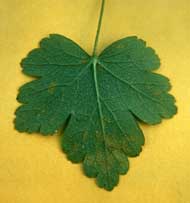WHITE PINE BLISTER RUST (Cronartium ribicola )
The disease White
pine blister rust (WPBR) is more prevalent in New York in the Southern
Tier, Catskill, and Adirondack regions. Trees in the Lake Plain, Hudson River
Valley and Long Island regions are least likely to become
infected. Within these regions the probability of infection is higher in frost
pockets, river and creek beds, and valleys where humidity is likely to be high
for long periods of time. Infection is least likely to occur on south-facing slopes
and in flat, open fields with good air movement. Eastern white pine is the main
host in New York.
Fig. 1. A blister rust canker showing the yellow-orange aecial state. Spores may be visible for up to 5 weeks.
As the fungus grows it produces a canker on the infected branch and begins to girdle it. Needles on that branch turn yellow and finally brown as the flow of sap to them is cut off. The fungus grows from that branch to the main stem, and the tree may show slowed growth and off-color foliage. It may take a few years for the fungus to encircle the stem and kill the tree. In the spring, the WPBR fungus produces spores on infected hosts. They are a bright, yellow-orange color and are produced on the cankers.
Spores produced on white pine infect the alternate hosts,
i.e. Ribes sp. Infections on Ribes sp. give rise to
a type of
spore which may re-infect Ribes sp. throughout the summer. In late
summer, a third type of spore is produced, on Ribes leaves, which can infect white
pine needles. At least 3 years must pass from the time of initial infection on
white pine until production of the next generation of spores.
of
spore which may re-infect Ribes sp. throughout the summer. In late
summer, a third type of spore is produced, on Ribes leaves, which can infect white
pine needles. At least 3 years must pass from the time of initial infection on
white pine until production of the next generation of spores.
Fig 2. Spore stage on alternate host Ribes
There are no known chemicals for treating or preventing WPBR. Weed control to improve air circulation will help prevent infection from getting started. Proximity to Ribes plants is important as native and introduced plants are susceptible. Black currant seems to sustain more infection, and state law forbids planting of black currant, Ribes nigrum, in some parts of the state. Eradication of native and introduced Ribes plants within 200 feet of a plantation will help to minimize disease incidence. Plants can either be pulled (you must get all parts of the root) or killed with herbicides. Branch infections that have not reached the main stem, can be pruned off. Prune branches at least 6 inches in from the margin of discolored bark.
Fig. 3.
An old blister rust canker on white pine. Note the presence of large quantities
of dried resin around the canker.
Return to Pest Menu